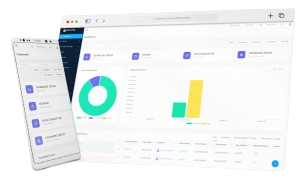Inventory turnover is a crucial metric for any business dealing with physical goods. It measures how often a company sells and replaces its inventory over a specific period. A higher turnover rate usually signals strong sales and efficient inventory management, while a lower rate can indicate overstocking or sluggish sales. Understanding and optimizing inventory turnover is key to reducing costs, improving profitability, and staying competitive in any industry. This guide will break down what inventory turnover means, how to calculate it, and why it matters for your business’s success.
What is Inventory Turnover?
Inventory turnover, or the inventory turnover ratio, measures how quickly a business sells and restocks its inventory within a set period. It’s calculated by dividing the Cost of Goods Sold (COGS) by the average inventory for the same timeframe. A high turnover rate indicates that products are moving off the shelves quickly, suggesting strong demand and efficient inventory management. Conversely, a low turnover rate could point to slower sales or overstocked items, leading to higher storage costs and potential losses. Understanding inventory turnover helps businesses make informed decisions about stocking levels, market demand, and overall operational efficiency.
How to Calculate Inventory Turnover
Calculating inventory turnover is straightforward. The formula is:
Inventory Turnover Ratio = Cost of Goods Sold (COGS) / Average Inventory
Here’s how it breaks down:
- Cost of Goods Sold (COGS): This represents the direct costs involved in producing or purchasing the products sold during a specific period.
- Average Inventory: To find the average inventory, add the beginning and ending inventory for the period and divide by two.
For example, if a company’s COGS for the year is $500,000, with a beginning inventory of $100,000 and an ending inventory of $150,000, the calculation would look like this:
- Average Inventory = ($100,000 + $150,000) / 2 = $125,000
- Inventory Turnover Ratio = $500,000 / $125,000 = 4
This result means the company sold and replaced its inventory four times during the year. A higher turnover ratio suggests efficient sales, while a lower ratio may indicate slow-moving inventory.
Sourced from: Corporate Finance Institute
What Do Inventory Turnover Ratios Indicate?
Inventory turnover ratios provide valuable insights into a business’s efficiency and market responsiveness.
A high turnover ratio is generally a positive sign, indicating that products are selling quickly. This reduces holding costs like storage and insurance while freeing up cash for other operations. It often points to strong demand and effective inventory management.
On the other hand, a low turnover ratio can signal potential issues, such as overstocked products or slow sales. This can tie up capital and increase inventory obsolescence risk, especially in rapidly changing industries.
Businesses often compare their turnover ratios with industry benchmarks to assess performance. A ratio that aligns with or exceeds the industry average suggests competitive efficiency, while a lower ratio might highlight areas for improvement.
Strategies to Improve Inventory Turnover
Improving inventory turnover requires a strategic approach to manage stock efficiently and meet market demand. Here are key strategies to enhance your turnover rate:
- Accurate Demand Forecasting: Use sales data and market trends to predict future demand. This helps avoid overstocking and ensures popular items are readily available.
- Streamline Inventory Levels: Focus on maintaining lean inventory by stocking only what’s necessary. This reduces the excess and minimizes storage costs.
- Strengthen Supplier Relationships: Build strong partnerships with suppliers to secure better pricing and reliable restocking schedules, allowing faster inventory turnover.
- Promotions and Discounts: Use targeted promotions, discounts, and marketing campaigns to boost sales of slow-moving items and clear outdated stock.
- Utilize Inventory Management Tools: Leverage software and tools like Arm POS, these tools are designed to track stock levels, automate reordering, and provide real-time data, helping you make informed inventory decisions.
Implementing these strategies can lead to a healthier turnover rate, lower holding costs, and improved profitability.
The Impact of Inventory Turnover on Business Performance
Inventory turnover directly influences a business’s overall performance and profitability. A high turnover rate often indicates that products are in demand and selling well, leading to lower storage costs and reducing the risk of inventory becoming outdated. This efficiency allows businesses to free up capital, invest in new stock, and respond quickly to market changes.
Conversely, a low turnover rate can negatively affect a business. Slow-moving inventory ties up cash that could be better utilized elsewhere, increases storage expenses, and raises the chance of markdowns or write-offs for unsold goods. Monitoring and optimizing inventory turnover ensures that a business remains agile, cost-effective, and capable of meeting customer expectations, ultimately contributing to a stronger bottom line.
Common Mistakes in Managing Inventory Turnover
Mismanaging inventory turnover can lead to higher costs and reduced profitability. Here are common pitfalls to avoid:
- Overstocking Inventory: Holding too much stock ties up cash and increases storage costs. It also raises the risk of items becoming obsolete, leading to markdowns or losses.
- Neglecting Demand Variability: Ignoring seasonal trends or sudden shifts in customer preferences can result in either stock shortages or excess inventory. Regularly update forecasts to match changing demand.
- Infrequent Inventory Monitoring: Failing to track inventory levels regularly makes it challenging to spot trends and inefficiencies. Conduct consistent audits to ensure accurate records and better inventory control.
- Relying Solely on Manual Processes: Using outdated or manual inventory systems can lead to errors and missed opportunities. Invest in automated tools to streamline management and maintain accurate data.
Avoiding these common mistakes helps ensure efficient inventory management, leading to better financial outcomes and smoother operations.
Advanced Tips for Managing Inventory Turnover
To optimize inventory turnover and stay ahead in a competitive market, consider these advanced strategies:
- ABC Analysis: Prioritize inventory by categorizing items into three groups: A (high-value, low quantity), B (moderate value, moderate quantity), and C (low-value, high quantity). Focus your attention on A items to maximize profitability.
- Just-In-Time (JIT) Inventory: Implement JIT strategies to order stock only when needed, minimizing holding costs and reducing waste. This approach requires strong supplier relationships for timely deliveries.
- Regular Inventory Audits: Conduct frequent physical counts and reconcile them with inventory records. This helps identify discrepancies, track trends, and adjust strategies accordingly.
- Implement Safety Stock Levels: Keep a small buffer of high-demand items to handle unexpected surges. This prevents stockouts without overburdening storage.
- Leverage Data Analytics: Use analytics tools to monitor sales patterns, seasonal trends, and customer behavior. Data-driven insights enable more accurate forecasting and better decision-making.
These advanced techniques enhance inventory efficiency, reduce costs, and support sustained business growth.
Conclusion
In conclusion, inventory turnover is a crucial metric that directly impacts your business’s efficiency and profitability. By understanding how to manage your inventory effectively, you can ensure that your products move quickly, reducing holding costs and maximizing cash flow. Integrating a robust Point of Sale system with your inventory management not only simplifies tracking but also enhances sales accuracy. Additionally, leveraging human resource management practices ensures that your team is well-equipped to respond to inventory needs efficiently. Prioritizing inventory turnover helps you stay competitive and responsive in a fast-paced market, ultimately contributing to your business’s long-term success.






